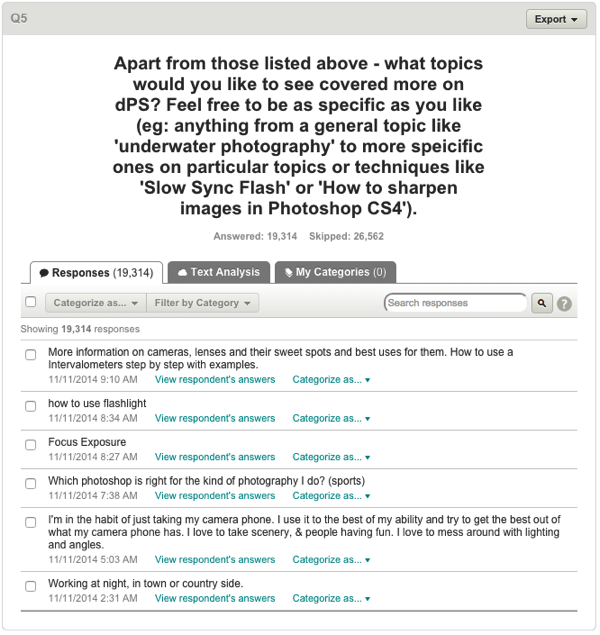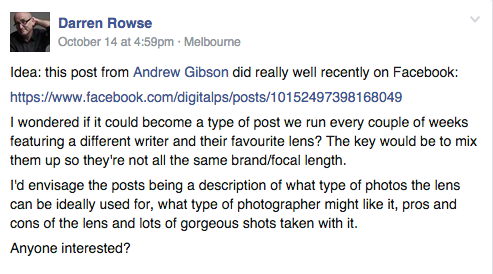Have you ever spent hours writing a quality piece of content only to see it scrape in a few social signals and deliver a handful of new visitors to your site?
We’ve all been there.
The problem is that in the era of content marketing so many people are drilling you with the notion that quality content is the key to building links and generating online traffic.
Wrong.
The fact is, great content doesn’t promote itself. In fact,
writing killer content is less than half battle.
The real magic lies in content promotion. Without it, your content will struggle to earn a social mention, let alone a quality backlink.
This post will cover 16 advanced content promotion strategies. The most successful online marketers are using them every day to generate social buzz, build links and deliver boat loads of targeted traffic to their site…
…and you can too.
In fact, I’ve used many of these tactics to
drive ~11,700 visits to this blog in the seven weeks since it’s launch -

This guide is a
5,000 word beast, so I included a table of contents for your quick reference.
#1:
Snip.ly
#2:
Weekly Roundups
#3:
Link Poaching
#4:
Scoop.It
#5:
Buzzbundle
#6:
Google Plus Communities
#7:
Subreddits
#8:
Social Media Timing
#9:
Snippets
#10:
Promote The New With The Old
#11:
Facebook Lookalike Audiences
#12:
Outbrain
#13:
Sulia
#14:
Blog Aggregators
#15:
LinkedIn Groups
#16:
Twitter Card Hacks
DOWNLOAD FREE PDF, PLUS EXCLUSIVE FORUM MARKETING STRATEGY
#1: Snip.ly
Sniply is a powerful new tool that allows you to use content curation to drive targeted traffic to your website.
What if I told you that you could use a piece of awesome content written by an influencer in your industry and use it to drive a wave of targeted traffic to your site?
Here’s how to do it -
Head over to sniply and log in -

Next, find a popular piece of content that is related to your new blog post. For this example, I’ll use my post about recovering from a Google penalty -

Now, I’ll copy the URL of the top ranked post for this search query and enter it into Sniply -

Hit the “snip” button.
Next, customize the way you would like your ‘snip’ to appear using the fields below -

Select the ‘button’ action type, this will place a CTA button on the curated content that will direct people back to your site.
Enter an attention-grabbing message that is related to the piece of content you have written. Make sure the message indicates added value for the reader.
Next, customize the button text and enter the destination URL of your content.
Hit create and copy the custom sniply URL -

Now, head over to Twitter and re-share the influencer’s content using your new sniply URL -
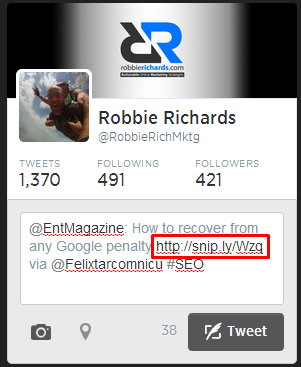
Bonus Tip: When you curate the content always make sure you mention the author’s name along with the publisher. Leverage influencers to maximize the CTR on your sniply link.
When someone clicks on your Sniply link they will be exposed to the message and CTA you set. When people click on the “read more” button they will be redirected to your site -
 Sniply also provides an anlaytics dashboard so you can see which snips have generated traffic to your content.
The clicks metric tells you how many users actually clicked on your sniply link, whereas the “engagement” metric indicates how many people click the CTA button linking back to your site -
Sniply also provides an anlaytics dashboard so you can see which snips have generated traffic to your content.
The clicks metric tells you how many users actually clicked on your sniply link, whereas the “engagement” metric indicates how many people click the CTA button linking back to your site -

#2: Weekly Roundups
Weekly link roundups might be one of the most underrated content promotion strategies on the planet. Where else can you find people that are actively looking to link (and send targeted traffic) to your content?
If you’re not familiar with roundups, they are simply blog posts that link out to the week’s best content.
The key here is to find roundups that have a large readership and receive a ton of social engagement.
The first step is to find popular roundups related to your industry.
Here’s how -
Type in the following search strings to find weekly roundups in your niche -
“link roundup” + your industry
“weekly link roundup” + your industry
~KW + “link roundup”
 “KW” + inurl:roundup
“KW” + intitle:roundup
“KW” + inurl:roundup
“KW” + intitle:roundup
If there is a particular site that you would like to see if they publish a link roundup, type the following search string -
site:domain.com +”roundup”
Make sure you set it so Google is only returning search results for the past month -
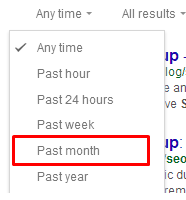
Next, head over to Twitter and run the queries in the search bar -

You will need to make sure you are entering broader search queries to increase the number of results being returned -

Next, make a list of the sites publishing roundups on a regular basis and take note of their contact information.
Now it’s a matter of reaching out to the bloggers and suggesting your content.
Here is the exact template I use -
Hey NAME,
First, I just want to say thanks for the great weekly roundups you’ve been putting together over at the BLOG NAME. I’ve been getting a ton of value from them.
I’m writing to let you know about a new piece of content I published that shows business owners YOUR BLOG TITLE.
I’ve found this strategy particularly effective for building links for local SEO. You can read the post here: BLOG URL
I thought you might like to add it to your weekly roundup.
Either way, keep up the great work!
Cheers,
Robbie.
P.S. Would love to know what you think about the post?
Back To Top
#3: Link Poaching
The best way to build links to (and promote) your content is to find people that have already linked to similar content and introduce them to your new (and improved) content.
There are a number of great
backlink checkers out there. Two of my favorites are
Ahrefs and
Open Site Explorer.
First, do a quick search in Google to identify topics similar to yours -

Next, copy the URL of the top result. This piece of content likely has a large number of quality links pointing to it.
Enter the URL into your backlink checker of choice -
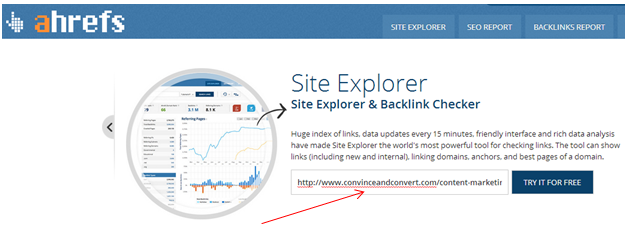
Navigate over to the “inbound links” section and select the “links” option -

This will give you a list of all the pages linking to the URL -

Head over to each site and copy the site’s contact email address.
Reach out to the webmaster with this template -
Hey NAME,
I just wanted to say that I’m loving the blog. I actually came across a great post of yours today, POST NAME.
As always, great stuff!
I noticed that you have a link to POST NAME
I really like this resource, some very valuable content in there. In fact, it inspired me to write an updated version called ENTER YOUR POST NAME. You can check it out here: POST URL. Might be worth adding to your article.
Either way, keep up the great work!
Cheers,
YOUR NAME
Rinse and repeat this technique for the top 10 search results and you’ll have a solid list of link prospects.
Back To Top
#4: Scoop.It
Scoop.It is a content curation platform, and is one the best ways to promote content and build quality backlinks.
It’s basically a platform where people collect their favorite content from across the web and publish it in a magazine format similar to Paper.li and Flipboard. The best part, many of these publication have 2+ page rank value and can deliver boat loads of targeted traffic to your site.
Here’s what a Scoop.It page looks like -

This is a
PR3 page with 27,000 views.
First, create an account. Click the “my topics” button and choose “create topic” -
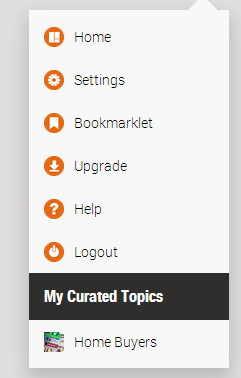
Make sure that your topic is related to the content you have written.
Next, search for Scoop.It pages that curate content similar to what your content is about -
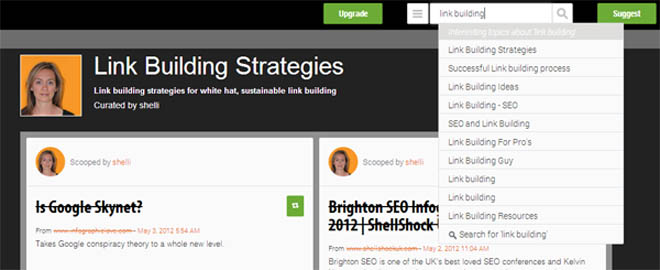
Make sure the pages you target with your content have a large number of page views, and ideally a large Twitter following. Generally, active “scoopers” (creative, I know) will also share their content on Twitter.
Follow all the people with popular Scoop.It pages and large Twitter followings.
Now it’s time to suggest your content. Navigate back over to one of the popular Scoop.It pages and hit “suggest” -

Select the appropriate Scoop.It page from the dropdown and hit “suggest”.
This will notify the owner that you have suggested content for their Scoop.It page. If they like your content, they’ll post it to their page and you’ll have a link referring targeted traffic back to your site.
Scoopers usually share their Scoop.It pages on Twitter, so you can potentially get double the bang for your buck.
Bonus Tip: To increase the number of Scoop.It prospects you can target, click the dropdown next to the search bar and see if there is a category related to your content -

Next, click the “recommended topics” tab -

You will then be given a list of popular Scoop.It related to that category. Suggest your content to any related pages -

Check out
this page with over 28,100 views.
Next, check if the owner of the Scoop.It page is active on Twitter -

Engage and start building a a relationship. This will give you another audience to leverage for the promotion of your content -
 Back To Top
Back To Top
#5: Buzz Bundle
BuzzBundle is one of my absolute favorite online marketing tools. Hat tip to
Matthew Woodward for introducing me to this tool.
BuzzBundle is great for both content promotion
and link building. It allows you to monitor and track conversions related to specific keywords and brand mentions across a number of channels, including -
- Blogs
- Social networks
- Forums
- Q&A sites
It allows you to quickly find your target audience and engage in the conversations related to your content and area of expertise.
Here’s how to do it -
Once you’ve installed the free
BuzzBundle desktop application, open it up and click “create new project” -
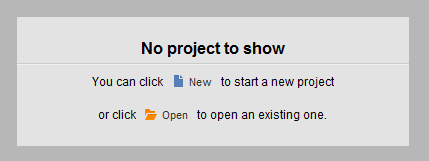
Hit “Create New Stream” and enter the keywords and URLs you want to track. For this example we’ll use “link building” as our keyword target (add as many as you want) -
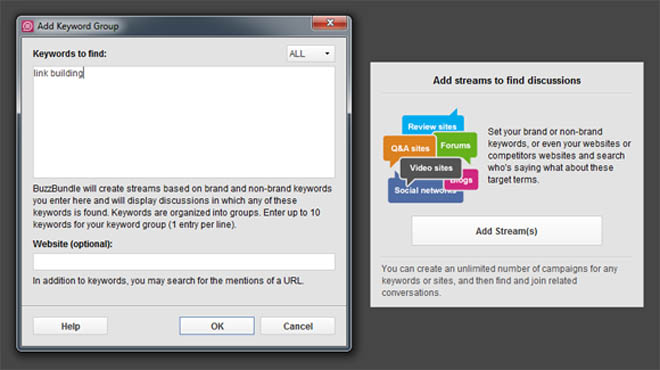
You will then see a list of streams highlighting content and conversations surrounding the topic of “link building” -

It may take a while for the streams to fully populate.
The threads that have been grayed out are only accessible with the paid account. The free account currently gives you access to 30% of the threads, which is still plenty to engage and promote your content to the right people.
Create a persona
After you’ve selected the keywords and URLs you want to track, it’s time to create your persona. This is the identity you will be using to engage in conversations online -
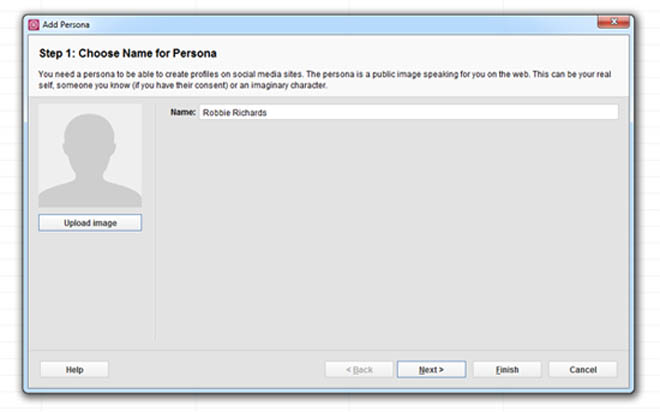
Type in your username, password, email and email password.
BuzzBundle requests the password to your email account in order for verification purposes.
Then, you can add your social media profiles -
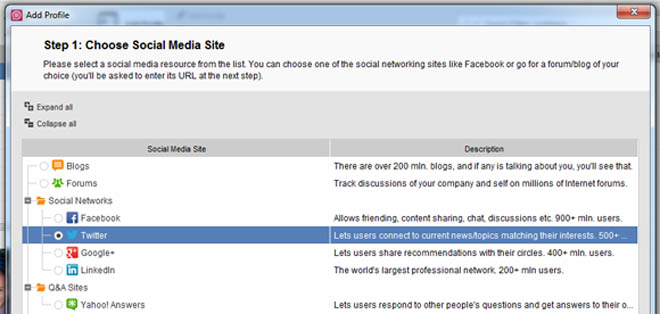
Now you’re ready to start buzzing!
Get your buzz on
Once you have your persona completed and keywords added click the “Find Buzz” button. You can also filter the types of websites you want to monitor -

BuzzBundle will go out and scrape all the content listed on social media sites, forums, blogs and Q&A sites related to your keywords.
Once you find a post that you like start engaging. I look for people asking questions related to the content I have already written.
For example, this person is asking about different link building techniques on Twitter. You would engage this person -

And provide him with a link to your post -

Or, you might find a question in a forum that you can drop your link in -

This is a great strategy for engaging your target audience and driving traffic to your site. It also provides an opportunity to build links directly through forum, blog and Q&A comments, as well as build links indirectly through social engagement.
The more your content is shared the more people will see it, the more people that see it the more likely you are to get some backlinks.
On the topic of social engagement…
BuzzBundle provides you with the ability to filter social media conversations. This is great if you find a piece of content similar to what you have written that has gained a lot of social engagement -

Enter the post’s URL into the search filter and look through all the people that engaged with that post. These are the people you will want to reach out to -
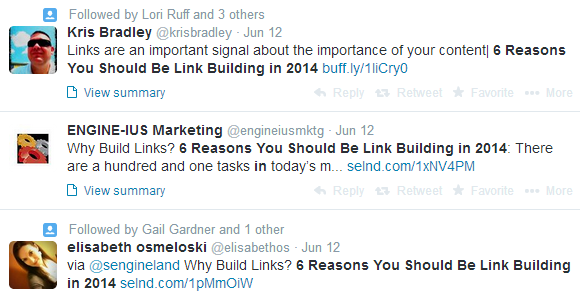
I would reply with something simple like this -
“Hey @person, if you liked [insert post name] then you will want to check this out [insert your link]“
Now you have a powerful weapon to find your target audience, engage and drive traffic to your content.
DOWNLOAD FREE PDF, PLUS GET EXCLUSIVE ACCESS TO MY FORUM MARKETING STRATEGY
Back To Top
#6: Google Plus Communities
Google Plus communities provide a targeted channel to promote your content.
As the name implies, Google Plus communities are online groups where like-minded individuals interact and share content.
There are thousands of communities targeting almost every industry and topic under the sun.
Once you have written your piece of content, head over to Google Plus and select “communities” from the left navigation -

In the top search bar enter a keyword related to your industry or the topic of your content -

Scroll through and “join” all the communities related to your niche -

Next, copy the URL of your content and head back over to your Google Plus profile.
Paste the URL into the “link” box and add an attention-grabbing message -
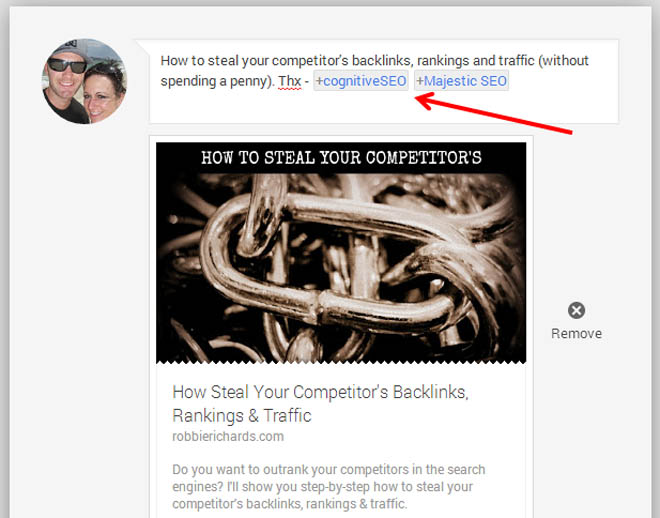
When posting your content be sure to mention others you have referenced in your work (where applicable) and select the relevant community you want to post the content -
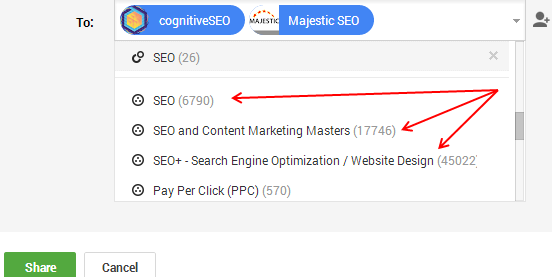
Your content will now be exposed to people with an expressed interest in the topic you have written about. These readers are more likely to engage with your content and click-through to your website.
Bonus tip: It’s a good idea to engage with (+1, comment, share) other content in the communities before you begin promoting your own content.
Also, spread out the frequency with which you share content in communities. Here’s some great advice from Google Plus expert,
Mark Traphagen -
“Google+ runs automated spam detection for posts to communities. Posting the exact same content to multiple communities in a short span of time can get the posts flagged as spam. Flagged posts get sent to a penalty box seen only by community moderators, and the post will never be seen by the community unless a mod decides to set it free.
No one knows the exact thresholds for the auto-flagging, but my advice is to vary the intro text in your posts, and spread them out over several days if you’re targeting multiple communities.”
Back To Top
#7: Subreddits
Reddit is another popular online social media community you can leverage to promote your content to a targeted audience.
An effective strategy is to utilize subreddits. These are niche communities of people voting and commenting on a variety of content types.
Simply find a subreddit related to your content and share it with the community. As people ‘vote’ for your content it will rank higher in the subreddit.
Head over to Reddit and register for a free account.
Once logged in, click the “submit a new link” button -

Next, enter an attention-grabbing title, enter your URL and select a subreddit related to your content -

Hit “submit”.
Another option is to submit your content as a text post.
Follow the same process as submitting a link, but this time select the “text” option at the top of the page -

Now, enter a catchy introduction for your content with a link to read the full post on your site -

Using the text post layout gives your audience a taste of what they will find in your post and can be effective in increasing the CTR to your website.
Tip: Make sure you engage with other people’s content within the subreddits. Vote, comment and share other content. If you only use the platform for self-promotion you will quickly be banned. Give a little before you take
 Back To Top
Back To Top
#8: Timing Is Everything
When promoting your content on social media, timing is everything.
This is especially true on the more popular social media channels such as facebook, Twitter and Google Plus where millions of people are posting and sharing content every day.
In order to get as many eyes on your content as possible, you need to be posting when the largest number of people are online and engaging.
Here’s how to do it -
Tweriod
Tweriod is a free tool that tells you when the largest number of your followers are online and engaging with content -

Hit the “go to dashboard” button on the homepage and then sign in with your Twitter account.
Next, click the “my analysis” tab -

Now, you can see the times when the largest number of your Twitter followers are online, as well as the times when your content is likely to get the most exposure -

Take this insight and optimize the times at which you are scheduling your content to go out on Twitter.
Facebook Insights
The facebook insights tool is great for identifying when your fans are online.
Log into your facebook account and click the “insights” tab -

Then, hit the “posts” tab -

Now you can see which days, and at what times, your fans are on facebook -
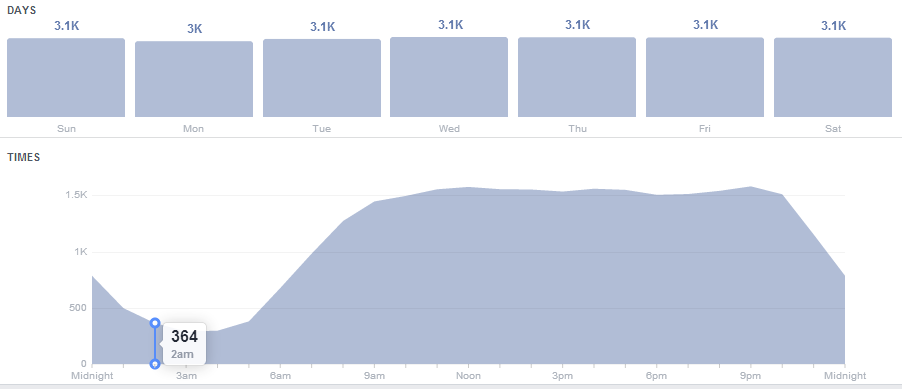 Timing +
Timing +
Timing + is a free tool that will give you a quick snapshot of the best times to post on Google Plus.
Head over to Timing + and sign in with your Google account.
You will then be able to see which posts have performed that best and which time of the day posts get the most engagement -

Now, head over to
Buffer and begin scheduling your content when people are online -
 Back To Top
Back To Top
#9: Leverage Snippets
When it comes to social content promotion, many bloggers and business owners suffer from what I like to call “set it – forget it” syndrome – they write a killer post, identify the best times to post, and then only post the content once, usually immeditely after it’s published.
This is a HUGE waste.
What if your fans and followers aren’t online when you first post your content? Your post goes unseen.
Instead, you should leverage snippets to post your content frequently across social media channels and increase your blog traffic.
Here’s how to do it -
Don’t use the same title when posting multiple times as this will look spammy. Instead, use snippets.
For example, if I was going to promote this blog post I might try the following -
Tweeting the title:

Pose a question:

Quote the author:

Some other ideas include -
- Citing a statistic
- Mentioning an influencer
- Making a bold statement such as “Why your blog traffic sucks and what you can do about it”.
Go into your content and pull out at least 20 different snippets using the frameworks above.
Use Buffer to schedule your content at different times – using the insights you gathered from the previous strategy.
In terms of post frequency on Twitter, you should be promoting your content at least once a day for the week immediately after publishing content, and then twice weekly for the remainder of the month.
Post to facebook twice in the first month after publishing the content.
Post to Google Plus every week for the first month.
There are a number of free plugins you can use to automate content scheduling -
Evergreen Post Tweeter
Tweet Old Post
Back To Top
#10: Promote The New With The Old
You can leverage older archived content to promote your new content.
Open your
Google Analytics account and look for the most popular pages on your website. Make sure you filter the date range for the past 60 days as content that is older will skew the results. You want to identify which content on your site is hot right now.
Click the “behavior” tab within your analytics account and select “all pages” -

Take a look at which content is getting the most page views and the highest average time on page -

You can also click on the “landing pages” option and see where people are entering your site. If you notice an overlap between the highest traffic landing pages and those with the longest time on page, include a link to your new content.
Next, head over to
Social Crawlytics to determine which content on your site gets the most social engagement.
Enter your home page URL, allow crawling of subdomains, and set the page depth to ’10′. This will ensure that all the content on your site is being crawled -
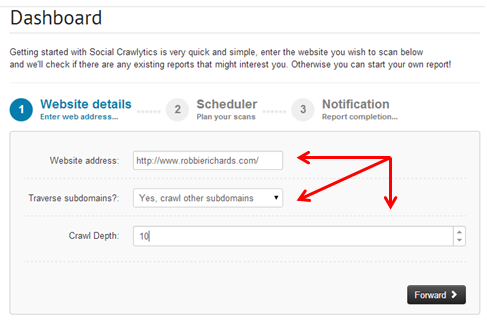
Click “forward”.
The tool will then email a report with containing social engagement metrics for all the content on your site.
Finally, on your most trafficked and shared pages, place internal links to your new content (where relevant).
This is great for channeling page rank and new visitors to your new post.
DOWNLOAD A FREE PDF, PLUS GET ACCESS TO MY FORUM MARKETING STRATEGY
Back To Top
#11: Facebook Lookalike Audiences
When you use
Custom Audiences, you can choose to create a lookalike audience that targets the top 1-5% of people who have similar interests to the people on your custom audience list.
There are number of ways you can leverage lookalike audiences to promote your content. One effective strategy is to create an audience based off of your email list.
Here how to do it -
Log into your facebook account and select “power editor” from the left navigation bar -

Now, select “audiences” from the dropdown in the top left of the page -

Hit “create audience”, and select the source you wish to use. If you have a MailChimp account, you can create a custom audience that contains all of the email contacts from your account. If you use another email service provider, export your contacts as an excel file and create your custom audience.
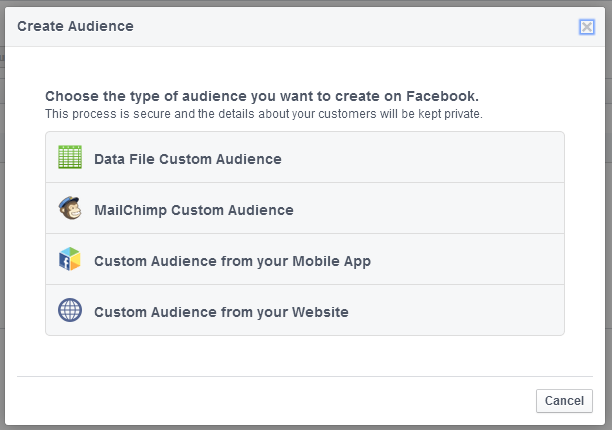
Jon Loomer has an
in-depth post that will show you everything you need to know about creating custom audiences.
Click on the “audiences” tab and select “lookalike” audience -

Select the custom audience you want your lookalike audience to be built off. In this case it will be an email list titled “LF Leads” -

You will have the opportunity to optimize the lookalike audience for “reach” or “similarity”. This will depend on your campaign goals.
Now, create a facebook ad promoting your new piece of content. Use your lookalike audience to get your content in front of a new audience with similar interests to your existing fans or customers.
Bonus Tip: You can also create a custom website audience (WCA) within facebook’s Power Editor tool.
A WCA will allow you to retarget users that have previously visited your site. This is a powerful targeting feature as these users have already shown an expressed interest in your content.
Here’s how to do it -
Open the Power Editor and click “create audience” >> “custom audience” -

Next, select the “custom audience from your website” option.
Give your audience a name and description. Then, define whether you want to target all website visitors, or only those users visiting a particularly page on your site.
Set the duration of the audience. This will depend on the industry you are in. If your sales cycle is long, set the duration for 60-90 days -

Click “create”.
Finally, copy and paste the facebook retargeting pixel into the <head> section of your website.
Your WCA will grow as users visit your site.
Back To Top
#12: Outbrain
Outbrain is a service that promotes content on other pieces of content, based on the targeting criteria you set. For example, if you’ve ever read articles on sites such as Fast Company you likely noticed the “you might also like” section below the post -

You can get your content promoted here too.
The more clicks your content receives, the more it will be recommended across the web.
Outbrain can get your content featured on some high profile websites and drive a ton of targeted traffic to your site.
The cost per click is relatively low compared to other advertising platforms. I’ve seen an average cost per click around $0.10.
There are a number of other paid content distribution services out there such as -
nRelate
Taboola
Back To Top
#13: Use Sulia Snippets To Reach Millions
Sulia is a popular content-sharing site where you can use catchy headlines and graphics (or videos) to get the attention of millions of readers searching for content.
Sign into Sulia and write an attention-grabbing headline. Add an image or video, then include a link back to your site -

This is a great channel to use some of the content snippets you created earlier.
Here is an example of a Sulia snippet curated from a Moz Whiteboard Friday -

Readers are able to “push” your content across to other related Sulia channels, as well as tweet the snippet or share it on facebook.
All of which are great opportunities for added content exposure.
Back To Top
#14: Submit Your Site To Blog Aggregators
AllTop is a blog aggregator that collects the best blog content from across the web.
The platform is great for both content promotion and link building for four reasons -
- They pull content from your RSS feed, which links back to your site.
- Links are often ‘followed’
- Backlinks from aggregators usually pass crazy amounts of page rank to your site
- Blog aggregators provide topical categories that receive huge amounts of traffic
AllTop is arguably the most respected aggregator on the web with millions of active monthly readers.
Check out the site’s backlink profile (PR7) -

You can easily funnel page rank and targeted traffic to your site using this platform.
Here’s how to do it -
First, create a “My AllTop” account and verify your email -

Next, scroll to the bottom of the homepage and click “submissions”.
Before you submit your site to AllTop you will need to select the most relevant category as it relates to your site’s content, and have an RSS feed URL.
For most sites, especially WordPress-powered sites, you can find your RSS feed URL at
yoursite.com/rss.
To find the best category for your site, head back over to the home page and search for a keyword that relates to the content on your blog -

AllTop will present you with a list of categories. Select the best one for your site -

Finally, you will need to fill out the submission form -

In the comments section, type a description that speaks to the credibility of your site. This can be anything from the number of published posts, your social following, page rank, or even better, any awards or recognition your site has received.
There are a number of aggregators that you should look at -
http://technorati.com/ (PR8)
http://www.bizsugar.com/
http://www.blogarama.com/
http://www.bloghub.com/
http://regator.com/
http://www.icerocket.com/
BloKube.com
http://www.bloglines.com/
Blog aggregators should be utilized for two reasons -
Submitting content to blog aggregators will build high PR backlinks and deliver targeted traffic to your site.
Back To Top
#15: LinkedIn Groups
This is one of the most powerful, yet underrated content promotion strategies on the planet.
LinkedIn Groups provide the following opportunities -
- Targeted content promotion
- Direct line of communication with industry influencers
- Relationship building
LinkedIn is one of the top traffic referral sources for my recent
link building guide -

I promoted the link building guide in three LinkedIn groups and it has
generated 418 pageviews in 17 days!
Here’s how to leverage LinkedIn Groups for content promotion -
Head over to LinkedIn and search for a keyword related to your content or industry.
Select “groups” from the dropdown next to the search bar -

You will see a list of groups related to the keyword you entered.
Some of these groups have tens of thousands of members -

Request to join any groups related to your content and blog. Then, submit your post within the group.
Make sure you engage with other content and members within the community. This is a fantastic way to build connections with influencers in your industry and build your personal brand.
But wait, there’s more…
LinkedIn Groups also provide the opportunity to get inside an influencer’s inbox without even having their email address.
However, you do need to have a connection with them.

One way to build connections with influencers is to build connections with their connections (become a 2nd degree connection).
However, the quickest way to build a connection with an influencer on LinkedIn is to look at their profile and identify the groups they members of.
Join any groups the influencer is a member of.
As a member of a shared group, you’ll be able to send a connection request.
Once the influencer accepts your invitation to connect, you’ll be able to send them a direct message.
Your connection will then receive a notification in their email inbox.
Here is a sample message you could use -
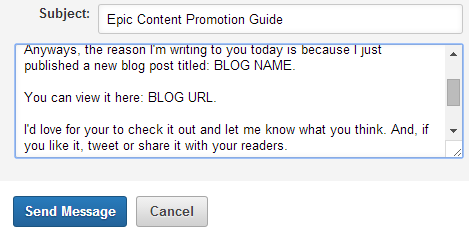 Back To Top
Back To Top
#16: Free Twitter Cards
Twitter lead generation cards are another effective tool for promoting your blog, white paper, ebook and email list.
The best part, you can use them for free.
First, what exactly are Twitter cards?
A lead generation card in Twitter is a form that can be attached to your Tweet that allows your followers to directly send you their contact information with the click of a button. Here’s an example -
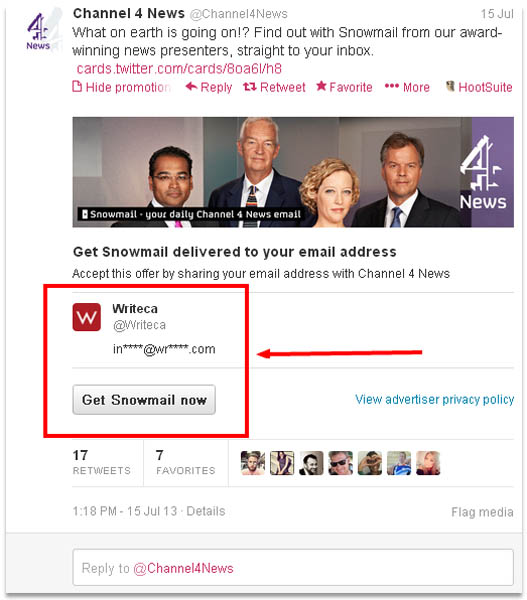
As you can see, the box is pre-populated with the recipient’s email address. This eliminates any barriers. The user doesn’t have to manually enter their email address, it’s pulled directly from their Twitter account.
Now, remember I told you this wouldn’t cost you a dime….
The beauty is that
you can add a lead generation card to a regular non-promoted tweet.
Here’s how to do it -
Log into your Twitter account, click the gear icon and then select “Twitter Ads” from the dropdown.
Click the “creatives” tab and select “cards” -

Next, click the “create your first lead generation card” button -

Then, you will arrive at this page. Enter in all the necessary information -
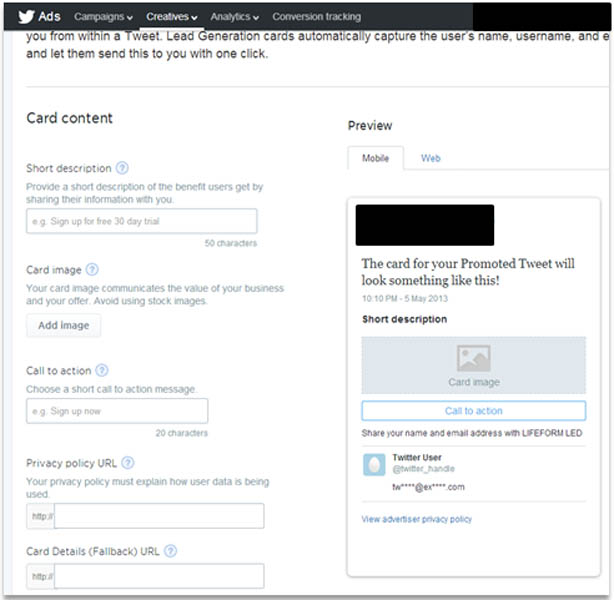
Note: You need to have a link to your company’s privacy policy, as well as link to a page where the user can find out more about your business/ blog.
Now, hit the blue “compose tweet” in the upper right hand corner.
Hit the “attach a twitter card” button and select the card you created in the previous step -

Send your tweet.
You will now have a card that will collect user emails when they click the CTA in your twitter lead generation card.
Back To Top
FREE BONUS: Download a free PDF of this post. Plus, get exclusive access to the forum marketing strategy that is driving my #1 source of referral traffic.
Final Thoughts
Writing great content is only half the battle. In order to realize the true fruits of your labor – backlinks, social engagement, higher rankings and boat loads of traffic – you need to dedicate just as much time to promoting your content as you do writing it.
The content promotion strategies listed above are used by some of the most successful online marketers on the planet. I’ve personally implemented every one of them with great success.
Now it’s your turn to reach a larger audience and drive serious amounts of traffic to your site.




